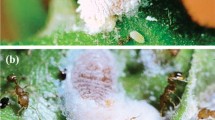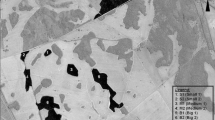Abstract
A tree species, Macaranga bancana , distributed in South East Asian tropics has a mutualistic relationship with specific symbiotic ant species, which defend the plant from herbivores. To examine the intraspecific variation in the status of the ant-plant symbiosis among microhabitats of different light conditions, we investigated the species composition of nesting ants and the herbivory damage on M. bancana saplings by field observations and sampling in primary and secondary forests in Sarawak. In addition, the effectiveness of non-ant (physical and chemical) defenses were estimated by feeding the larvae of a polyphagous lepidopteran with M. bancana leaves from saplings in the two types of forests. All saplings in the primary forest were colonized by two Crematogaster ant species that had been known to be the obligate symbionts of M. bancana, while in the secondary forest, about half of the saplings were occupied by several ant species that were not obligate symbionts. There was little herbivory damage on saplings colonized by the two Crematogaster symbiont ants in both forest types, while the saplings colonized by the other ant species suffered a 10–60% loss of leaf area. Larval mortality of the polyphagous lepidopteran Spodoptera litura was significantly higher when larvae fed on leaves of M. bancana saplings in the secondary forest than when fed on leaves of M. bancana saplings in the primary forest. These results suggest that the symbiosis between ants and M. bancana is looser and the non-ant-defenses are stronger in secondary forests, where light is more intense, than in primary forests.



Similar content being viewed by others
References
Agrawal AA, Rutter MT (1998) Dynamic anti-herbivore defense in ant-plants: the role of induced responses. Oikos 83:227–236
Beattie AJ (1985) The evolutionary ecology of ant-plant mutualisms. Cambridge University Press, Cambridge
Begon M, Harper JL, Townsend CR (1996) Ecology, 3rd edn. Blackwell Science, Oxford
Buckley RC (ed) (1982) Ant-plant interactions in Australia. Junk, The Hague
Chazdon RL (1986) Light variation and carbon gain in rain forest understorey palms. J Ecol 74:995–1012
Coley PD, Bryant JP, Chapin FS (1985) Resource availability and plant antiherbivore defense. Science 230:895–899
Davidson DW, Fisher BL (1991) Symbiosis of ants with Cecropia as a function of light regime. In: Huxley CR, Cutler DF (eds) Ant-plant interactions. Oxford University Press, Oxford, pp 289–309
Davidson DW, McKey D (1993) The evolutionary ecology of symbiotic ant-plant relationship. J Hymen Res 2:13–83
Davies SJ (1998) Photosynthesis of nine pioneer Macaranga species from Borneo in relation to life history. Ecology 79:2292–2308
Davies SJ, Palmiotto PA, Ashton PS, Lee HS, LaFrankie JV (1998) Comparative ecology of 11 sympatric species of Macaranga in Borneo: tree distribution in relation to horizontal and vertical resource heterogeneity. J Ecol 86:662–673
Eck G, Fiala B, Linsenmair KE, Hashim RB, Proksch P (2001) Trade-off between chemical and biotic antiherbivore defense in the South East Asian plant genus Macaranga. J Chem Ecol 27:1979–1996
Fiala B, Maschwitz U (1991) Extrafloral nectaries in the genus Macaranga (Euphorbiaceae) in Malaysia: comparative studies of their possible significance as predispositions for myrmecophytism. Biol J Linn Soc 44:287–306
Fiala B, Maschwitz U, Pong TY, Helbig, AJ (1989) Studies of a South East Asian ant-plant association: protection of Macaranga trees by Crematogaster borneensis. Oecologia 79:463–470
Fiala B, Grunsky H, Maschwitz U, Linsenmair KE (1994) Diversity of ant-plant interactions: protective efficacy in Macaranga species with different degrees of ant association. Oecologia 97:186–192
Fiala B, Jakob A, Maschwitz U, Linsenmair KE (1999) Diversity, evolutionary specialization and geographic distribution of a mutualistic ant-plant complex: Macaranga and Crematogaster in South East Asia. Bot J Linn Soc 66:305–331
Folgarait PJ, Davidson, DW (1994) Antiherbivore defenses of myrmecophytic Cecropia under different light regimes. Oikos 71:305–320
Herms DA, Mattson WJ (1992) The dilemma of plants: to grow or defend. Q Rev Biol 67:283–335
Huxley CR, Cutler DF (eds) (1991) Ant-plant interactions. Oxford University Press, Oxford
Inoue T, Hamid AA (eds) (1994) Plant reproductive systems and animal seasonal dynamics: long-term study of dipterocarp forests in Sarawak. Center for Ecological Research, Kyoto University, Otsu
Itino T, Itioka T (2001) Interspecific variation and ontogenetic change in antiherbivore defense in myrmecophytic Macaranga species. Ecol Res 16:765–774
Itino T, Davies SJ, Tada H, Hieda Y, Inoguchi M, Itioka T, Yamane S-K, Inoue T (2001) Co-speciation of ants and plants. Ecol Res 16:787–793
Itioka T, Nomura M, Inui Y, Itino T, Inoue T (2000) Difference in intensity of ant defense among three species of Macaranga myrmecophytes in a Southeast Asian dipterocarp forest. Biotropica 32:318–326
Janzen DH (1966) Coevolution of mutualism between ants and acacias in Central America. Evolution 20:249–275
Kato M, Inoue T, Hamid AA, Nagamitsu T, Merdek MB, Nona AR, Itino T, Yamane S-K, Yumoto T (1995) Seasonality and vertical structure of light-attracted insect communities in a dipterocarp forest in Sarawak. Res Popul Ecol 37:59–79
Koricheva J, Larsson S, Haukioja E, Keinanen M (1998) Regulation of woody plant secondary metabolism by resource availability: hypothesis testing by means of meta-analysis. Oikos 83:212–226
Larsson S, Wiren A, Lundgren L, Ericsson T (1986) Effects of light and nutrient stress on leaf phenolic chemistry in Salix dasyclados and susceptibility to Galerucella lineola (Coleoptera). Oikos 47:205–210
Longino JT (1989) Geographic variation and community structure in an ant-plant mutualism Azteca and Cecropia in Costa Rica. Biotropica 21:126–132
Maschwitz U, Fiala B, Davies SJ, Linsenmair KE (1996) A South-East Asian myrmecophyte with two alternative inhabitants: Camponotus or Crematogaster as partners of Macaranga lamellata. Ecotropica 2:29–40
McKey D (1974) Adaptive patterns in alkaloid physiology. Am Nat 108:305–320
McKey D (1984) Interaction of the ant-plant Leonardoxa africana (Caesalpiniaceae) with its obligate inhabitants in a rainforest in Cameroon. Biotropica 16:81–99
McKey D, Davidson DW (1993) Ant-plant symbioses in Africa and the neotropics: history, biogeography, and diversity. In: Goldblatt P (ed) Biological relationships between Africa and South America. Yale University Press, New Haven, Connecticut, pp 567–606
Nichols-Orians CM (1991a) Environmentally induced differences in plant traits: consequences for susceptibility to a leaf-cutter ant. Ecology 72:1609–1623
Nichols-Orians CM (1991b) The effects of light on foliar chemistry, growth and susceptibility of seedlings of a canopy tree to an attine ant. Oecologia 86:552–560
Nicotra AB, Chazdon RL, Iriarte SVB (1999) Spatial heterogeneity of light and woody seedling regeneration in tropical wet forests. Ecology 80:1908–1926
Nomura M, Itioka T (2002) Effects of synthesized tannin on the growth and survival of a generalist herbivorous insect, the common cutworm, Spodoptera litura Fabricius (Lepidoptera: Noctuidae). Appl Entomol Zool 37:285–289
Nomura M, Itioka T, Itino T (2000) Variations in abiotic defense among myrmecophytic and non-myrmecophytic species of Macaranga in a Bornean dipterocarp forest. Ecol Res 15:1–11
Okamoto D, Okada S (1968) Studies on the tobacco cutworm, Spodoptera litura , Fabricius, as an insect pest of the forage crop (in Japanese). Bull Chugoku Natl Agric Exp Stat Ser 2:111–144
Rehr SS, Feeny PP, Janzen DH (1973) Chemical defence in Central American non-ant-acacia. J Anim Ecol 42:405–416
Seemann JR, Sharkey TD, Wang J, Osmond CB (1987) Environmental effects on photosynthesis, nitrogen-use efficiency, and metabolite pools in leaves of sun and shade plants. Plant Physiol 84:796–802
Siemens DH, Garner SH, Mitchell-Olds T, Callaway RM (2002) Cost of defense in the context of plant competition: Brassica rapa may grow and defend. Ecology 83:505–517
Simms EL (1992) Costs of plant resistance to herbivory. In: Fritz RS, Simms EL (eds) Plant resistance to herbivores and pathogens: ecology, evolution, and genetics. The University of Chicago Press, Chicago, pp 392–425
Whitmore TC (1969) First thoughts on species evolution in Malayan Macaranga (Studies in Macaranga III). Biol J Linn Soc 1:223–231
Whitmore TC (1975) Macaranga. In: Airy Shaw HK (ed) The Euphorbiaceae of Borneo. Kew Bull Add Ser 4:140–159
Yu DW, Davidson DW (1997) Experimental studies of species-specificity in Cecropia -ant relationships. Ecol Monogr 67:273–294
Zangerl AR, Bazzaz FA (1992) Theory and pattern in plant defense allocation. In: Fritz RS, Simms EL (eds) Plant resistance to herbivores and pathogens: ecology, evolution, and genetics. The University of Chicago Press, Chicago, pp 363–391
Acknowledgements
We thank Hua Seng Lee, Tohru Nakashizuka and Takayuki Ohgushi for providing support and assistance for this study. We also thank Abang A. Hamid and Sarkawi M. Umar and the staff of Entomological Unit of Forest Research Centre, Sarawak for providing research facilities. We are grateful to Takao Itino and Aya Hatada for fruitful discussions. Diane W. Davidson is acknowledged for valuable comments on an earlier draft of the manuscript. Thanks are also due to Tomoaki Ichie and Michiko Nakagawa for help in the field. This work was supported partly by the Japan Ministry of Education, Culture, Sports, Science and Technology for International Scientific Research (#10041163) and by CREST of JST (Japan Science and Technology Corporation).
Author information
Authors and Affiliations
Corresponding author
Rights and permissions
About this article
Cite this article
Murase, K., Itioka, T., Nomura, M. et al. Intraspecific variation in the status of ant symbiosis on a myrmecophyte, Macaranga bancana, between primary and secondary forests in Borneo. Popul Ecol 45, 221–226 (2003). https://doi.org/10.1007/s10144-003-0158-4
Received:
Accepted:
Published:
Issue Date:
DOI: https://doi.org/10.1007/s10144-003-0158-4




